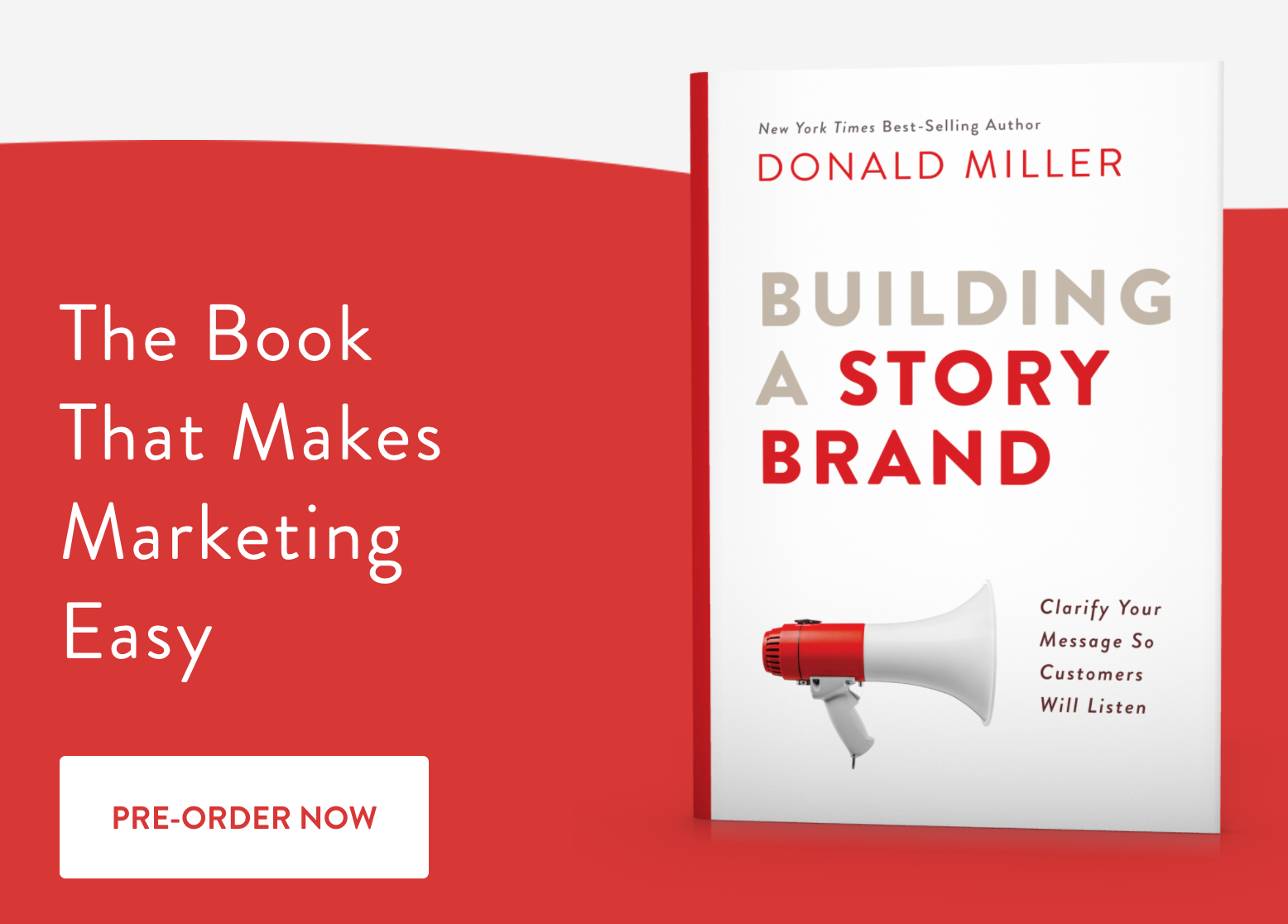
Episode Description
Ever thought about starting a business of your own?
Not everyone is ready to risk a secure job to launch a new enterprise. Some people really like their day job. And for many, a regular paycheck is a blessing.
That’s why I’m honored to have Chris Guillebeau joining us on the Building a StoryBrand podcast. He’s the author of Side Hustle: From Idea to Income in 27 Days and he’s going to show us how to quickly and easily create an additional stream of income without giving up the security of a full-time job.
Starting a side hustle can reward you in many ways. Not only will you earn extra money, you can add variety to your life, create a fun outlet or connect with a new community. And all this without risking a life-changing decision to leave your day-job.
Whatever your reason for starting a side hustle, listen to this podcast to learn the simple process it takes to make it happen. Chris blazes a clear path to help you earn extra income fast.
[LISTEN NOW ON APPLE PODCASTS]
What is a Side Hustle?
A side hustle is different than a part-time job. It usually means pursuing a hobby, doing something fulfilling, or challenging yourself, rather than driving for Uber or waiting tables at night for extra cash.
Though we might pursue our passion simply because it’s enjoyable, Chris points out that it’d be even better if your hobby actually made money. For example, Chris told me a story about a managerial accountant in Dubai who makes $1,000 a month producing poetry slams.
“It’s a totally different creativity process. He’s not going to quit his job as a managerial accountant because he likes it,” Chris says. “But he likes poetry, and he’s found a way to teach the specific workshop format that he does.”
The reasons for why you’re starting a side-hustle might be different, but the goal is the same: earn extra money on your own terms. You want to start something new without the pressure of trying to bank your whole living on it.
Week 1: Build an Arsenal of Ideas
You might be thinking, I don’t have a good entrepreneurial idea yet. I don’t even know if I would recognize one if I saw it.
Don’t worry. Chris addresses this problem in the first week by teaching you all about ideas, where they come from and how to spot them when they show up.
The goal of the first week is to be observant. As you go about your week, notice problems people are struggling with that you might be able to solve.
Don’t limit where your mind wanders. Draw ideas from:
- • Culture
- • Your personal life
- • Your background
- • The different skills you have
Chris says the question you should be asking is, “Is there anything I can create that might be valuable to someone?”
While you are gathering ideas, the secondary goal is to pay attention to where ideas come from — which happens to be everywhere. For some inspiring proof, check out how these entrepreneurs came up with their great ideas.
Chris recommends choosing about three to six good ideas that could potentially work. They don’t have to be in the same vein — one could be a service, one might be a product, and another may be to start a blog or a consulting service.
Week 2: Select Your Best Idea
What is the process for choosing the right idea for your side hustle? Fortunately, Chris’ plan provides a full week to make your selection. But should you pick the one that’s going to make the most money? Or one that ignites your passion?
The answer isn’t straightforward.
“It’s a pretty intuitive process,” Chris says.
He suggests ranking your ideas according to a few different criteria. For instance, one way to measure would be how much the idea motivates you. Since you’ll expend your energy and effort outside of your workday on your side hustle, it’s pretty important to be excited about it. Another way to gauge your ideas is by profit potential or how feasible it is.
What you want to avoid is feeling so pressured and overwhelmed that you don’t make a decision.
As you rank them, hopefully, a key theme will emerge. But if one doesn’t, don’t fret. What you want to avoid is feeling so pressured and overwhelmed that you don’t make a decision.
“I think it’s important to remind people that when you make this decision, you’re not making a decision for the rest of your life,” Chris says.
If you do this whole exercise and you still have three ideas that are ranked exactly the same, then pick one randomly.
“The worse thing that could happen is you get tired of it and you go back to one of the others,” Chris points out. That’s the beauty of a side hustle. It’s forgiving.
Week 3: Prepare for Liftoff
After 21 days, it’s time to launch.
“When you prepare for liftoff,” Chris says, “you’re going to do everything needed to get that project out to the world.”
This can be overwhelming because there are so many different resources online, Chris says. It’s important to really simplify what you need so you can succeed.
One of the best ways to clear your path to lift-off is to define your offer — identify your deliverables.
“People don’t buy ideas,” he says. “They buy a product. They buy a service.”
After you define your offer, you can work backward to figure out what you need to do. Remember Chase Reeve’s advice on how to reverse engineer your goals.
Week 4: Launch Your Idea to the Right People
In the final week, it’s time to launch your idea, but Chris adds a caveat — to the right people.
Who are the right people?
The answer is your ideal customer. The nice thing about a side hustle is you don’t have to mess with complicated business strategies like a target market or customer research.
The nice thing about a side hustle is you don’t have to mess with complicated business strategies like a target market or customer research.
Instead, Chris says you can ask, “Who’s that one person out there with the pain point or problem I’m trying to solve? What are their goals? What are their aspirations?” At StoryBrand, we teach you how to identify the problem your customer is having. By understanding your customer’s problem, you can speak to them in a way that’s meaningful to them.
“I’m trying to encourage people to get this process going pretty quickly,” Chris says, so it’s important to keep it simple.
When you think of how to speak clearly to just one customer, it will speed things along and clarify your marketing strategy. For more advice on how to launch a product, listen to Jeff Walker share the Secrets of a Successful Product Launch to make your side hustle a big hit.
Week 5: Regroup and Refine
I think it’s important to remind anyone who is getting ready to start a business that, first, it’s a blast.
Second, it’s okay to fail.
Chris points out, “You’re just not going to get it right the first time.”
Starting something up is always a messy process. Unfortunately, a lot of people will try something and, if it doesn’t work, they stop. Instead, keep moving forward.
Chris agrees. That’s why he’s already built in a time for regrouping and refining your product. This time of review is invaluable. Many times, we’ve launched something at StoryBrand and weren’t happy with the results. So, we sat down and refined it and our initial revenue would double, triple, and quadruple.
Instead of placing huge expectations on your side hustle— either of it being a huge success or a colossal failure— recognize that your initial liftoff will probably land in the middle of those two extremes.
Instead of placing huge expectations on your side hustle— either of it being a huge success or a colossal failure— recognize that your initial liftoff will probably land in the middle of those two extremes. Your idea will work, but not quite like what you expected.
The beauty of the side hustle is that even if you don’t see that big success, you have the freedom to scrap the idea altogether and go back to that initial list. You have the freedom to start the process all over again.
—
If you’re looking for a challenge and wanting to earn some extra cash, starting a side hustle just might fit the bill. It can be extremely rewarding and meet your needs in ways your day-job can’t— without the risk.
Whatever your reason for starting a sideline, don’t get bogged down with expectations or details. Follow this simple process and see what happens. At the end of this month, you’ll learn a lot about yourself and about that special idea that just might be the key to earning more money in a fun and interesting way.
Tired of falling for marketing schemes that don’t work? Get all the results you’ve been searching for in one little book, Building a StoryBrand. Donald Miller teaches you how to clarify your message so your customers understand you. You’ll learn how to talk about your business in a way that captures your audience and you’ll get to the bottom of why your website (and other marketing collateral) isn’t working.
If you pre-order now, you’ll also get two huge bonuses — (a $148 value) for free!
*To get your bonuses, purchase the book from any retailer in any format and forward your receipt to bonus@StoryBrand.com











